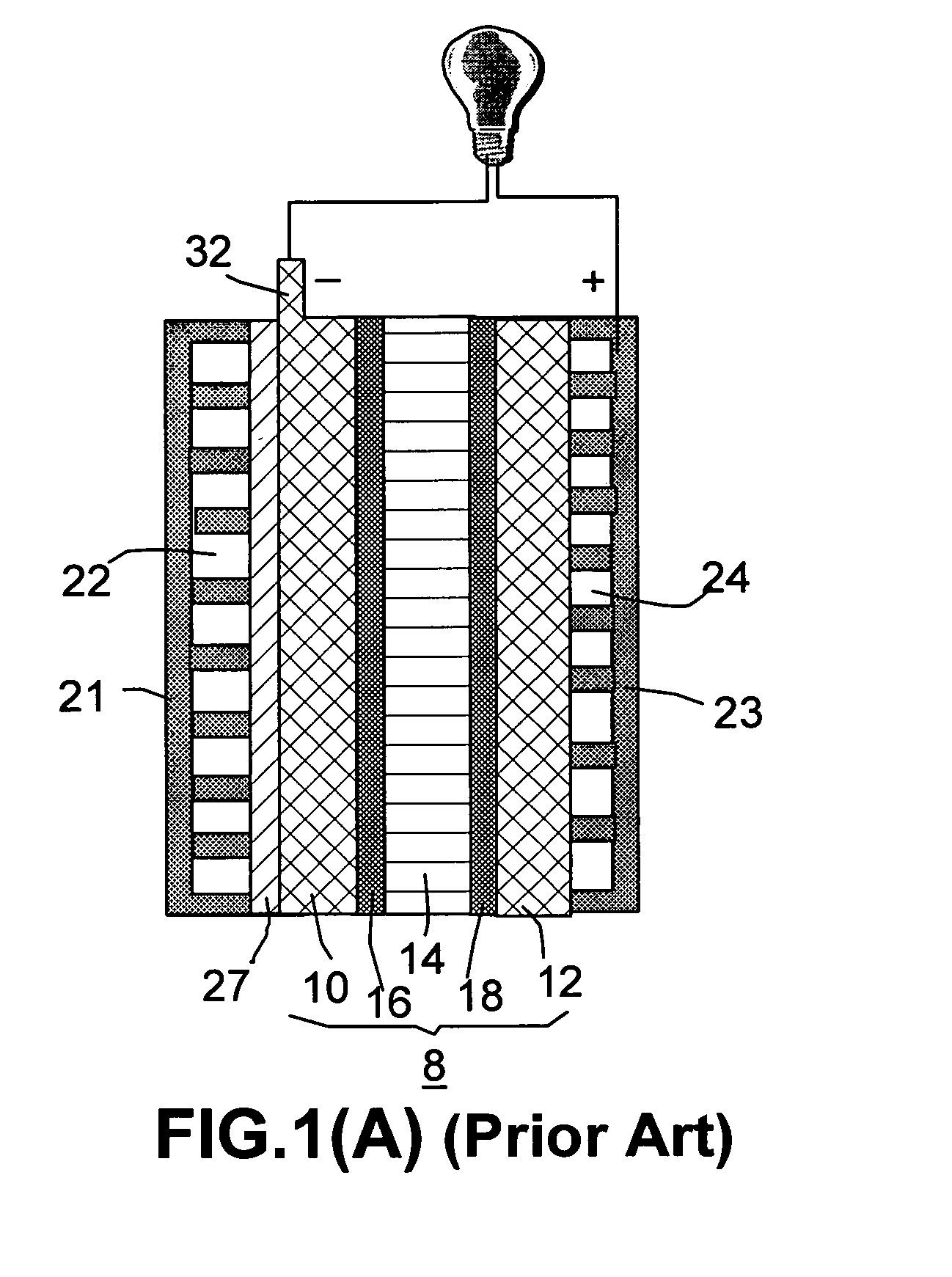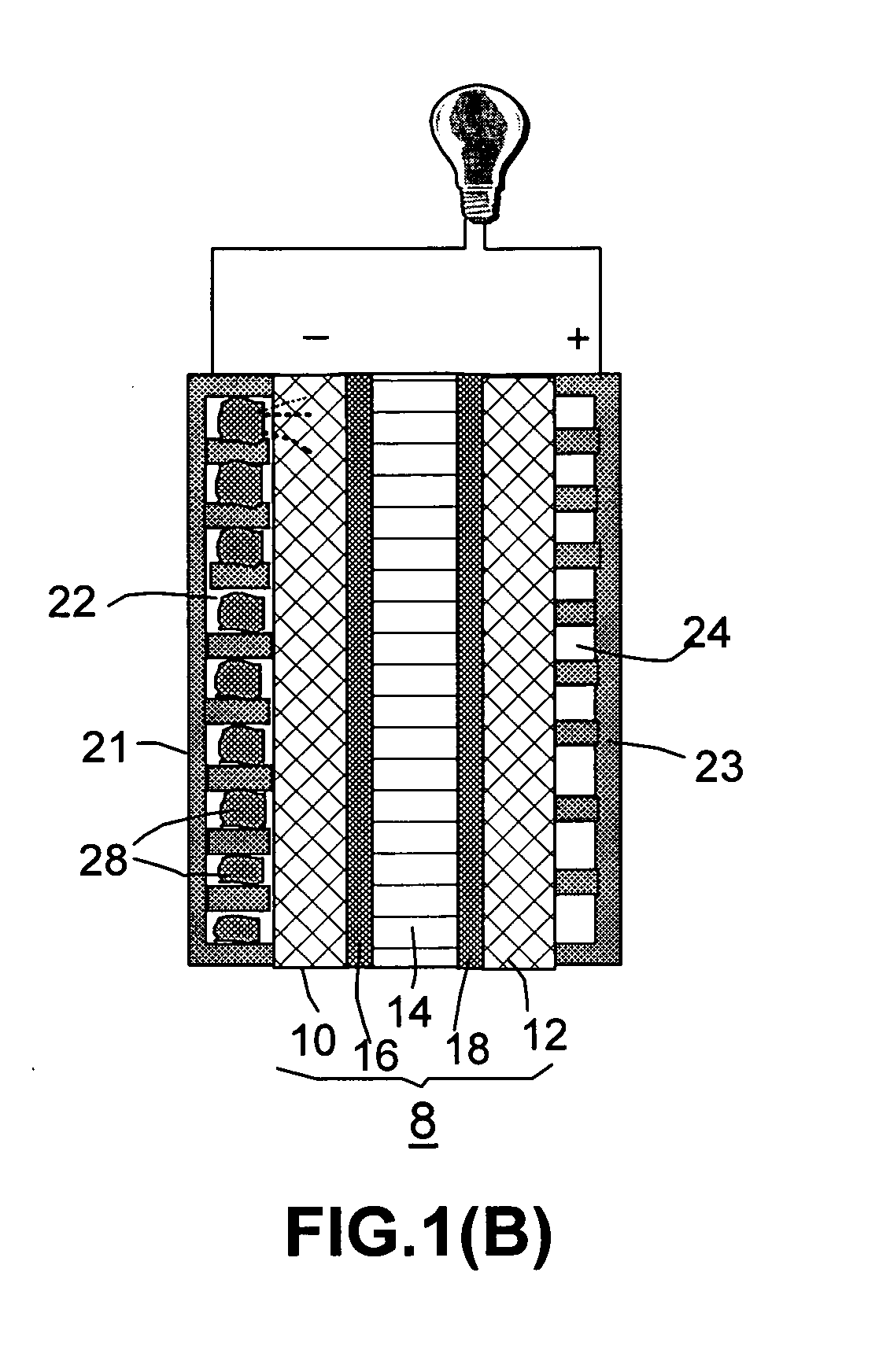Controlled-release vapor fuel cell
a vapor fuel cell, controlled technology, applied in the direction of cell components, electrochemical generators, cell component details, etc., can solve the problems of difficult and expensive fabrication and assembly, and achieve the effects of low fuel utilization, high fuel cross-over problems, and reduced methanol crossover
- Summary
- Abstract
- Description
- Claims
- Application Information
AI Technical Summary
Benefits of technology
Problems solved by technology
Method used
Image
Examples
example 1
Polyurethane-Based Controlled-Release Material
[0078] Polyurethane (PU) was prepared by the reaction of toluene-2,4-diisocyanate with hydroxy-terminated oligomers. Oligomers were either liquid polybutadiene (MW 3000) or propylene oxide-based polyethers (MW 420 and 4800). Polyurethanes with linking segments formed predominantly by high-molecular-weight oligomers (MW 3000 or 4800) were rubbery materials with a glass transition temperature (Tg) lower than room temperature. By contrast, hard glassy membranes (Tg>room temperature) were obtained if the linking segments comprised high amounts of a polyether with MW 420. When a fuel mixture of water and methanol was fed to a glassy PU material (with or without pores, the latter being like in a foam or sponge), the fuel liquid is absorbed and retained at a TTg, all glassy PU materials allowed for evaporation of methanol at reasonable rates. In the cases of rubbery PU materials, minimal evaporation occurs at room temperature, but significant ...
example 2
Poly (Vinyl Alcohol)-Based Controlled-Release Material
[0079] Poly (vinyl alcohol) (PVA) can be modified to obtain phosphatic anionic PVA (P-PVA) and quaternary ammonium cationic PVA (C-PVA) with various degrees of substitution (D.S.). The polyelectrolyte complex membrane prepared by mixing P-PVA (D.S.=2.3%) and C-PVA (D.S.=2.9%) with weight ratio of 1 / 1, showed a good evaporation rate at 75° C. or above. Additionally, cross-linked PVA material was prepared with poly (acrylic acid-co-maleic anhydride) (PAAM) serving as a polymeric cross-linking agent. Cross-linked materials were characterized by good water and methanol swelling and evaporation capabilities. Swelling ratio decreased with increasing cross-linking agent content since the swelling of water molecule is restricted by chemical cross-linking between PVA chains and polymeric cross-linking agent chains and physical cross-linking by entanglement between the chains. When the contents of cross-linking agent increased, evaporatio...
example 3
Methanol Selective Controlled-Release Materials
[0081] Polymeric membranes with excellent chemical resistance were prepared from polar polymers including NBR (Acrylonitrile-Butadiene Rubber) and Poly (vinyl chloride). These materials were cross-linked to form chemically and mechanically robust materials, which were all more capable of emitting methanol than water vapors. The permeation rates were negligible at room temperature, but become appreciable at 60° C. or higher.
[0082] The evaporation performance of polymer blends made from cellulose acetate and cellulose acetate hydrogen phthalate were also studied. All the tested material compositions were found to evaporate methanol preferentially. The selectivity increases and the evaporation rate decreases with increasing cellulose acetate content in the blend. When the feed temperature or the methanol content in the feed increases, the evaporation rates of a material with a 30 wt % in cellulose acetate are greatly enhanced and the sel...
PUM
| Property | Measurement | Unit |
|---|---|---|
| temperatures | aaaaa | aaaaa |
| boiling temperatures | aaaaa | aaaaa |
| boiling temperatures | aaaaa | aaaaa |
Abstract
Description
Claims
Application Information
 Login to View More
Login to View More - R&D
- Intellectual Property
- Life Sciences
- Materials
- Tech Scout
- Unparalleled Data Quality
- Higher Quality Content
- 60% Fewer Hallucinations
Browse by: Latest US Patents, China's latest patents, Technical Efficacy Thesaurus, Application Domain, Technology Topic, Popular Technical Reports.
© 2025 PatSnap. All rights reserved.Legal|Privacy policy|Modern Slavery Act Transparency Statement|Sitemap|About US| Contact US: help@patsnap.com



